“Indonesia in Disorder” and “Islamophobia”
During the European and other tours, Kiai Kanjeng and Emha Ainun Nadjib have faced questions and even resistance with regard to their identity as Muslims. At times they felt challenged by what they described as two overriding “obstructions to communication,” namely the image of Indonesia as a “country in disorder” and the problem of “Islamophobia”, particularly as Kiai Kanjeng were very closely identified with Islam.
However, when Kiai Kanjeng were in front of an audience, things were very different. When the Australian audiences were presented with contemporary western music plus one or two Australian popular songs arranged in “gamelan” style, they promptly asked: “where is the Islamic music?” In a show specifically for high school students at Saint Richi, Kiai Kanjeng gave a simple gamelan version of Twinkle Twinkle Little Star. The students were openly demanding: “Give us the Islamic songs”, they cried. Kiai Kanjeng responded by playing a number of shalawat (songs in praise to the Prophet Muhammad), and the students spontaneously got up from their seats and danced. This event is captured on video and can be seen on the 2005 compilation release Kiai Kanjeng Greets UK.
In Aberdeen Kiai Kanjeng played an extended number from Lebanon. This was a piece of traditional Arabic music which, at certain points, they would change suddenly, breaking into ‘western’ sounding music without altering the note or the instrumental accompaniment. Then the ensemble would faithfully return to the original Arabic style. In these cases, the Arabic lyrics would be sung by Kiai Kanjeng vocalist, Yuli, and the English language version by Novia.
Amazing Grace had been played on the bagpipes by well-known Rowett Piper Duncan McPherson. He was given a background accompaniment on the saron and bonang (Javanese percussion instruments). The song was almost imperceptibly taken up by Kiai Kanjeng who introduced a medley of songs from Madura, Aceh and Timor with virtually no change in the melody. One observer wrote that “the melodies from various countries are connected to each other beautifully ‘in love’ even though the countries may be at odds with each other politically and economically and are “compartmentalised by walls.”
Community Music, Cultural Group
The audiences for Kiai Kanjeng performances overseas may consist of any of four main categories. The first category comprises the indigenous population. The second is formed of people of various other nationalities residing in or visiting a particular town where a performance is taking place. The third category consists of Indonesians residing or visiting the town and the fourth, non-Indonesian Muslims.
In Aberdeen the two shows at the Rowett Institute were largely attended by Scots. The Indonesians there were on the whole serving as members of the organising committee. On university campuses, such as that of School of Oriental and African Studies (SOAS) in London and those in Manchester, Birmingham and Leeds during the first tour of November 2004, the audiences had consisted of many different nationalities. The same had been true in Melbourne, while in Sydney and Canberra the audiences mainly comprised the children of junior and senior high schools, elementary schools and kindergartens, even playgroups. This is well-represented on the Kiai Kanjeng Greets UK (Video CD).
On the two UK and European tours the set list prepared by Kiai Kanjeng remained largely constant. There were original songs by Kiai Kanjeng. There were reworkings of modern and contemporary selections that had been given an “ethnic slant” as well as traditional and other ethnic Indonesian songs and “gamelanised” Western pop songs. For Britain the repertoire included Cat Steven’s Wild World and Morning Has Broken, Rod Steward’s Sailing, Bryan Adam’s Everything I Do and The Beatles’ I Saw Her Standing There.
Kiai Kanjeng’s tour of six Egyptian provinces in 2002 featured the “gamelanisation” of legendary Egyptian singer Ummi Kultsum’s songs. Since Egypt is familiar with French culture, particularly Alexandria, Kiai Kanjeng was ready with Alein, for example. For their tour of Germany and Italy, Kiai Kanjeng played in Berlin, Rome, Naples and Teramo, featuring gamelan versions of Eine Seefahrt, Grosser Gott, Guter Mond, Lucia, Sara and Solo Mio.
All of this was conducted in the spirit of inter-cultural communication. Discussions with Emha will quickly reveal that Kiai Kanjeng does not consider itself primarily a musical group, nor an arts group, but rather, first and foremost, a cultural group.
Though many recordings have been made over the years and cassettes and CDs made widely available in their native Indonesia, Emha and Kiai Kanjeng have made relatively few forays into the recording studio, considering the amount of time they spend performing as well as their vast musical output and repertoire. Instead they consider their music to be “community music”, to be presented at public performances, largely by invitation, to people of various ethnicities and nationalities, in various countries, to people of any religion, culture or of any identity.
During the last few years a number of recordings have been made but they have not received commercial distribution and are therefore in extremely limited supply. Nevertheless they are often remarkably stunning examples of Indonesian and world music and deserve the attention of academics, world music enthusiasts and collectors.
Kiai Kanjeng neither seek nor maintain links with the Indonesian government or business and industry. They perform generally only when invited by the public. Kiai Kanjeng believe that they are not considered particularly important by the Indonesian government. They also believe that the recording industry considers them a very poor prospect in terms of sales potential. Their success is based on the sheer numbers of people who enthusiastically buy cassettes and CDs, whenever they are available.
Kiai Kanjeng are always busy nonetheless simply because they receive so many invitations to perform. In the last seven years Kiai Kanjeng have been invited to perform at more than 1,000 events for various groups (and sometimes two or three performances are necessary), literally criss-crossing the vast territory of Indonesia by road and plane and requiring an intricately-balanced schedule. A dedicated team is required to coordinate these activities and ensure that all runs smoothly. A core team of three or four people, assisted by regional representatives and volunteers provides for and arranges this crucial logistical support.
For Kiai Kanjeng, music is just one element in cultural communications. Through music they say, many kinds of human communication can be explored including cultural dialogue, political discussion, spiritual enlightenment or simply giving oneself to the music in dance and spontaneous movement, free of any ties.
“Do we look Like Terrorists?”
In recent years, due to the economic crisis, political unrest and the outbreak of terrorism that began with the Bali bombings of October 2002, Indonesia has suffered from a relatively bad press, and in general Islamophobia can be said to have increased. Kiai Kanjeng have to able to assess the mood and psychology of an audience, working to immediately eliminate any negativity. In many major cities of the world, they ask the audience: “Please look carefully at our faces. Do we look like terrorists?” The response was always a roar of laughter.
Kiai Kanjeng’s view is that human and cultural openness can do away with political blocks between people. Any Islamophobia in their audience quickly became unimportant when they were greeted with Kiai Kanjeng’s faces, full of genuine smiles and laughter, and certainly not those associated with puritan or militant theologians. Kiai Kanjeng’s approach is one of universal friendship based on love between people and peoples, as reflected in the name given to the regular Jakarta event, Kenduri Cinta or Feast of Love, a theme to which Emha is constantly returning in his work.
Indonesian diplomats in the countries visited by Kiai Kanjeng generally say that in the last several years they have had difficulties in maintaining a good image of the country because of various events that have served to stigmatise Indonesia. Kiai Kanjeng, they say, helps to convey to the world the friendly and creative qualities of Indonesians.
What Kiai Kanjeng have done is most needed these days: cultural diplomacy. With just one or two hours on stage Kiai Kanjeng have succeeded in “touching” the communities and the media in the countries where they are performing. They are able to enter any segment of society - a feat that cannot be equalled via the formal functions of diplomats.
Kiai Kanjeng and Emha Ainun Nadjib have an international language in their music that affords them the ability to communicate where political phraseology has no opportunity to compete.
Berlin, Wednesday & Thursday, March 30th – 31st, 2005
Joking In Berlin, and National Leadership
Kiai Kanjeng had prepared 113 compositions for their second European tour. These spanned conventional pieces as well as karya-karya sapaan or popular local numbers presented in a gamelan style as a gesture of friendliness. Each show however, typically lasting 1.5 hours, afforded the opportunity to play only around ten numbers. In Indonesia a typical performance may last up to five hours.
For the first day’s performance in Berlin Kiai Kanjeng adopted the same approach seen elsewhere – there were jokes and the theme shifted repeatedly from arts to politics and other topics, and vice versa.
The performance would at times appear to be like any other musical performance, and then, as in Indonesia, it would be transformed into a platform for political and social oration, for spiritual contemplation and on to philosophical exposition before launching into biting satire.
But the audience was not allowed to dwell on the satire for long. They might suddenly find themselves mid in a discussion of a key concept such as national leadership – such as in Berlin where Cak Nun suddenly broke into Gundul-gundul Pacul to open a discussion on national leadership.
The next day, March 31st, saw the second Berlin performance, which one observer described as “orations interspersed with musical selections calculated to make the show accountable to the audience”. Again, the performance lasted approximately 1.5 hours and was “interrupted with roars of delight from the audience.”
This performance, held at the German Foreign Ministry’s “World Hall” was attended by German high officials and members of parliament, and ambassadors of various countries. It was hosted by the Indonesian Embassy in Germany in cooperation with the German Foreign Ministry. For Kiai Kanjeng and the embassy it was a forum where “the image of Indonesia was at stake”.
Kiai Kanjeng bore the mission of conveying the good image of Indonesia both politically and culturally. More precisely, they took it upon themselves to “submit a good account” of Indonesia and Islam in an international forum. Kiai Kanjeng were met with a roar of applause after each number and at the end of the show the audience gave them a standing ovation.
The official press release from the embassy stated that the Ambassador and the Indonesian community in Germany were very satisfied with the manner in which Kiai Kanjeng had successfully elevated the ‘good name’ of Indonesia and presented an “Islam that is friendly” to the international community.
Most of the audience for the first night of Kiai Kanjeng’s Berlin shows were Indonesians, while only a few were German. The second night’s show was a more formal event attended by 350 invited German government officials, ambassadors and 100 selected Indonesians.
Approaching the performance as if it had been a Maiyah gathering in Indonesia, the first show presented a very cultural atmosphere, full of laughter and jokes. There was the popular Indonesian dangdut music and many comical references to Indonesia’s wayang stories and legends. While Kiai Kanjeng made several artistic gamelan demonstrations, the evening was given over largely to “cultural delights” that were quite typically Indonesia and there was much laughter.
Topics covered on that first night included the earthquake in Nias, the havoc left by the tsunami in Aceh and fuel price increases. All were conveyed and understood with typical Indonesian wisdom. Many topical problems in Indonesia, the complications of which would appear to be almost unbearable, were made light of. There was a sense of optimism in Indonesian nationalism, in its “red-and-white” patriotism and the spirit and resolve to look forward and affirm that Indonesia could become the beacon of the world!
Emha was able to allude to complex political affairs and make them the material of his commentary to revive Indonesia’s faith in its “historical potential.” Emha spoke of “the wings of historical power flying to the beauty of the future.” He spoke of the unshakable spirit of Indonesians, struck by devastating tsunami, earthquakes, a thousand other disasters and other terrible things, natural disasters, technological disasters as well as human disasters.
Kiai Kanjeng had been very busy in Berlin. They had arrived from London in the morning and immediately had to prepare the equipment and the stage for that evening’s performance. The next morning they had a brief opportunity to go sightseeing but in the afternoon they had to prepare the stage at the Foreign Ministry building for that night’s performance. If the first night was an occasion for a light gathering, this second night would be one of cultural diplomacy.
Kiai Kanjeng were firm in their resolve to use their music and poetry to do all they could to restore a positive image of Indonesia in the eyes of the international community; to show the world that Indonesia is rich in natural, human and cultural resources. Until this point it was felt that the world had viewed Indonesia from a very narrow perspective. Now, through Kiai Kanjeng, the world could view Indonesia from a broader perspective.
Similarly, Kiai Kanjeng wished to encourage the world to find an Islam that would be synonymous with peace, an Islam that would contribute to feelings of greater safety among the peoples of the world. Novia would repeat in Berlin her recital of the same poems that she had read at The Moslem News Award of Islamic Excellence the previous week in London; poems that offered an interpretation of Islam as a religion of love and peace with a musical accompaniment arrangement by Kiai Kanjeng.
Nia and Yuli, who on the last day in London had been interviewed by the BBC and whose Qur’anic recital was recorded for a programme on Siti Khadijah (the first wife of the Prophet Muhammad), were again on hand to support Novia’s recital.
Indonesia’s Antara News Agency reported from Berlin that the strength of Novia did not lie merely in her mastery of language and management, but also in the very fact of her being a woman in the advanced stages of pregnancy. In the eyes of those who worked to promote gender equality and women’s emancipation, Novia’s leadership swept away any doubts about women’s capabilities and helped to dispel negative views of Islam and its treatment of women. Her prominence onstage and her leadership of the performance worked to confront the views of conservative clerics whose interpretation of Islam made the presence of women on stage taboo.
Among the foreign ambassadors attending Kiai Kanjeng’s performance on March 31st were those of Afghanistan, Bolivia, Burundi and Jordan. The Indonesian diplomats attending the show included those from the consulates in both Hamburg and Frankfurt.
The Kiai Kanjeng gamelan orchestra comprised 23 members in addition to Emha and Novia Kolopaking. Once again they treated audiences to Cat Stevens’ Wild World, Bryan Adams’ Everything I Do as well as Al-Athal and Hijrah Rasul by Egypt’s Ummi Kultsum and Kalimah by Majdah Rumi of Lebanon. Kiai Kanjeng worked to present a microcosm of Indonesia’s diversity by adopting a tonal system that created a fusion of atmospheres: Chinese, Western, Malay and Arabian music.
In his comments in the embassy press release, Indonesian Ambassador to Germany, Makmur Widodo, talked highly of the Kiai Kanjeng Orchestra and its place in the arts, and that their appearance and that of Emha was the fruit of an effort of the Indonesian Embassy in Berlin to introduce to the German public the Islam of Indonesia; an Islam which is friendly, through an intercultural concert.
Kiai Kanjeng in Rome, Friday, April 1st, 2005:
Tolerance, Democracy and Creativity
Kiai Kanjeng’s first show in Rome was a performance before the students of the University of La Sapienza, their teachers and rector, Prof. Renato Guarini, and the Indonesian community in Rome. Prior to the performance Emha had been plagued by doubts and a feeling that the timing was inappropriate. They had arrived just as Pope John Paul II had been taken seriously ill. It would be an affront if they were to perform in at atmosphere of levity. So, before the show Emha and Kiai Kanjeng held an internal meeting to analyse the situation and to prepare the right scenario for the performance. Fortunately their creativity allowed them to compose and arrange music appropriately adapted to the prevailing seriousness of the atmosphere.
Workshop at Rome International School, Monday, April 4th, 2005
During the 2003 tour of Australia, universities and schools in Canberra and Melbourne had invited Kiai Kanjeng to conduct workshops with their students. In Rome too Kiai Kanjeng were invited to hold workshops at the International School. The school building is located in the Campus di Parioli, a residential district. The school teaches almost all cultures of the world including Java and the gamelan.
Jijid, Joko Kamto, Bayu, Ardani, Joko SP and Kiai Kanjeng’s founder and leader Novi Budianto demonstrated how to play the saron, demung, boning, rebana and kendang. The 8th and 9th grade students were accustomed to exposure to various cultures and were very enthusiastic about the workshop, learning several Javanese children songs and playing the instruments. Just as in Australia, the young students danced and sung when Kiai Kanjeng played popular Italian children’s’ songs.
Rome, Tuesday, April 5th, 2005
“Poesia Per Un Grande”: Kiai Kanjeng’s Arrangement for Il-Papa
Kiai Kanjeng had been given approval by the Commune di Roma – the Mayor of Rome - to perform at Teatro Dalmazia at Municippio Due. However, the group were requested to play primarily spiritual numbers as the Italians were by then mourning the death of Pope John Paul II. “Niente Sole Mio, please,” no Sole Mio, please, said the mayor.
“Sole Mio”, My Sun, a love song, had been one of a number of well-known Italian songs that Kiai Kanjeng had prepared in gamelan arrangements for performances in several Italian cities. If it could not be played in Rome, could it be played in other cities like Teramo and Naples during this time of mourning? Emha waited for the development of the situation and the advice of the organizing committee.
Kiai Kanjeng understood the situation very well and they tried therefore to compose two new numbers specifically for the occasion, namely Obituary and Adagio. The latter was played in the accompaniment of the recital the poem Heart of Gold that was translated into Italian.
The initial publicity material for the April 5th show in Rome indicated that Kiai Kanjeng’s music is “known for its high dynamism, is very spirited and sometimes very wild”. But in the atmosphere of mourning in the wake of the passing of Pope John Paul II Emha and Kiai Kanjeng prepared a performance that focused more on the spiritual dimension, the human sadness experienced as a result of the death of the beloved Pope.
Although all members of Kiai Kanjeng are Muslims they had a high respect for the commitment of Pope John Paul II to the development of the sacred values of humanity and world peace. They expected that the world would receive a new pope who would fight together with everyone in the world against anything destructive to human life.
The Deputy Mayor of Rome, who had attended the show, was very enthusiastic about it and had enjoyed the performance immensely. The artistic setting for the concert, held in the Teatro Dalmazia, as well as the changes effected as a result of the mourning for the Pope meant that Emha and Kiai Kanjeng really had to exploit their talents to the utmost, arranging their musical numbers and presentation in a very different manner than that applied to earlier concerts in England and Scotland.
Once again, Emha made only one appearance on stage, namely to sing a Minang (West Sumatran) song. Unlike the performance at the University of La Sapienza, Emha made no orations or speeches at the Dalmazia performance. The songs were presented one by one and conducted throughout with a strict discipline, as well as an Italian commentary.
The nuns and churchgoers attending the show expressed their thanks and sincere appreciation. The performance had been very moving for the Catholics, mourning their Pope. The audience applauded the recital of Poem of Heart of Gold in Italian with a very long period of applause. The three first numbers, Obituary, Adagio and Duh Gusti (Oh, Lord), though “substantively” not Christian hymns, had been given “nuances and aesthetical formula” that could be perceived as having been intended to express condolences to the mourning hosts, the Italians. The choir of Imam Fatawi, Islamiyanto, Seteng, Nia and Yuli sounded as solemn as that of any church choir.
Ihab Hashem, a senior journalist from Palestine, said “This kind of group is very much needed by Europe or any other Western community elsewhere. By witnessing the performance of Kiai Kanjeng they can begin to know that Muslims can do more than just live in tolerance and democracy, but that they are also capable of a “cultural creativity” that might not even be possible in the West.
Teramo, Italy, Wednesday, April 6th, 2005
Sophisticated but Uncomplicated
The Teramo show was entitled “Grazie Italia” and was produced in cooperation with the organizing committee of “Festival Teramo Citta Apperta Almondo”. The programme commenced with an Italian band who played three Blues & Jazz numbers. Kiai Kanjeng followed with a performance lasting one and a half hours of their best songs. The audience applauded enthusiastically after each number and gave the group a standing ovation at the end of the performance.
Many other groups from Argentine, Italy, the United States, Germany and several other countries were participating in the festival. Kiai Kanjeng was accorded special treatment. The company had been invited, and played free of charge. The other groups participating had to pay and to register themselves one year in advance.
Furthermore, while Teramo and all other places throughout Italy had suspended many of their regional and national cultural and sports events out of respect for the deceased Pope John Paul II, Kiai Kanjeng was asked to perform in the festival. They played Pambuko I and II (Introduction), Recital of Emha Ainun Nadjib’s poems by Luluk, Gundul Pacul, Rampak Terbang, Tarian Rembulan (Moon Dance), O Sole Mio, Kalimah and Rampak Osing.
The Mayor of Teramo admired the arrangement of Kalimah with its “tiers of creativity”; sophisticated but not complicated. “I really appreciate it very much. The music of Kiai Kanjeng is very different from any music I have known. This is new for the Italians,” he said, promising further “cooperation” between Kiai Kanjeng and Teramo.
Naples, Thursday, April 7th, 2005
Flying the Red-And-White: From The Sumit of Imam Busyiri’s Shalawat to the “Mecca” of Classical Music
The concert at the Conservatorio Di Musica San Pietro A Majella, Naples, can be said to have been the “culmination of the achievement” of Kiai Kanjeng in their second tour of Europe. In London the company had successfully demonstrated their international values and cultural diplomacy.
In Aberdeen they “served the purpose of human and cultural relationship between the Indonesians and the Scots”. In the “World Hall” of the German Foreign Ministry “they presented their music to be woven obediently in the interests of political and cultural diplomacy”. In Rome they “presented their creativity for the beauty of inter-religious tolerance, particularly to accommodate the solemnity and mourning following the death of Pope John Paul II.”
Later, on April 9th, Emha would write in one of his frequent reports that in Naples he and Kiai Kanjeng had experienced a “great freedom” and had produced a “tremendous feast” establishing themselves as artists, creators, explorers of the aesthetic world, adventurers in melodies and lyrics, spiritual wanderers who could “fly” without the constraints of culture, politics or anything else.
Kiai Kanjeng had staged their music where the great masters of the world’s classical music once staged their works: Guiseppe Verdi, Robert Wagner, Guiseppe Tartini and Antonio Vivaldi. After staging their concerts these great masters left their musical instruments to be made museum items and thereby immortalized. The complex contains a museum that keeps these precious historic musical instruments that so attest to the musical creativity experienced there. Kiai Kanjeng too left their own artistic souvenirs in the form of the manuscript notations of their two well-known works, Pambuko I and Pambuko II (Overtures I and II) and the Demung written in gold ink.
Naples is one of the world’s centres of classical music. If you study classical music, wrote Emha in his report, you have to master the meanings of hundreds of Italian words and terms. Kiai Kanjeng have set their footprints on the summit of the highest peak in classical music, and flown the Red-and-White (the merah-putih or national flag of Indonesia) there.
Among the audience in Naples were Italian generals, intellectuals and businessmen. They applauded Emha and Kiai Kanjeng with cries of ‘Complimente, Complimente Maestro, Grazia Maestro!’ Emha later conceded that actually he had been embarrassed at being called ‘Maestro’ as he could not play in fact play any of the instruments of the true, classical maestros.
The concert in Naples was very formal, held in strict state protocol, as had been the performance in the Hall of the World at the German Foreign Ministry in Berlin. Neither Emha nor Kiai Kanjeng actually sang for this concert, performing instead a series of compositions especially composed and arranged for the occasion, of which the primary composition had never been played on the tour. The applause they received from this formal audience was the most enthusiastic of the entire tour. The generals appeared to lose all restraint, shouting, abandoning the etiquette of concert audiences.
Emha had understood that to be called “Maestro” was indeed an accolade to be taken seriously, since it had been expressed by professional musicians and special guests with an expert knowledge of music. One senior pianist asked Emha to come back to Naples “to process the creation of a composition” and to hold a concert with the local musicians”.
“Now I’m done for!” said Emha, acknowledging that the challenge was far beyond his capability.
This tour experience has been beyond the wildest imaginations of Emha and Kiai Kanjeng. Only two years earlier, they had toured six provinces of Egypt and they reached there the Summit of Mount Shalawat, the Mosque of Imam Bushiri of Alexandria, the composer of shalawat Burdah, which is widely sung with lyrics known by many of the Muslims of Indonesia. There, Kiai Kanjeng succeeded in meeting the Sheikh of the Mosque of Imam Bushiri. Kiai Kanjeng’s shalawat were greeted by the shalawat sung by the Sheikh. Kiai Kanjeng and the Sheikh then conversed in shalawat, and then they sang together several more shalawat.
The tours of Egypt, the UK and Europe had each culminated in their own particular peaks, be it the pinnacle of classical music, the heights of cultural diplomacy or the summit of Islamic shalawat. Each of the tours, in fact each of the individual performances, had each been different in terms of the composition of the audiences and their expectations. However, they all showed a common thread in that Emha Ainun Nadjib and Kiai Kanjeng have a universal appeal to all audiences.
A version of this text is due for inclusion in the book, "The Silent Pilgrimage", by Ian L Betts

































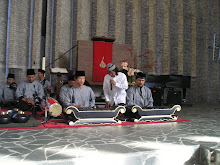
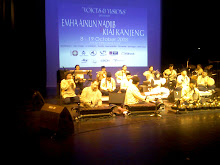

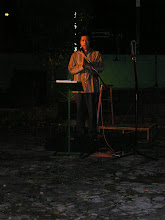



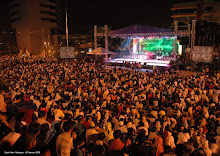
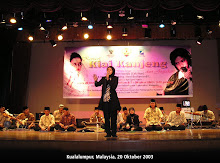
.jpg)






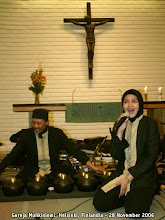.jpg)

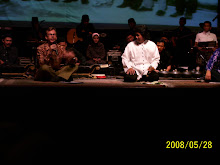.jpg)

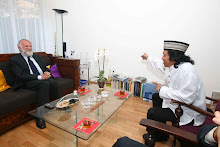
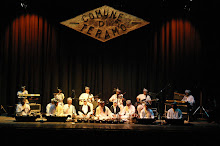




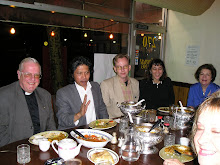


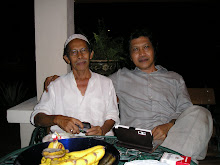
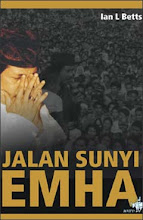
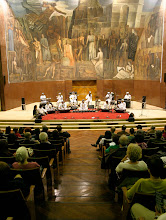
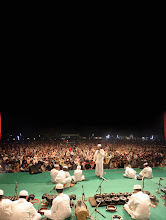

No comments:
Post a Comment